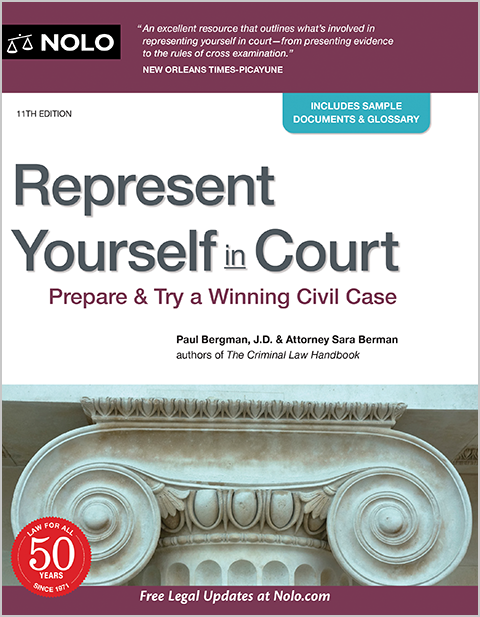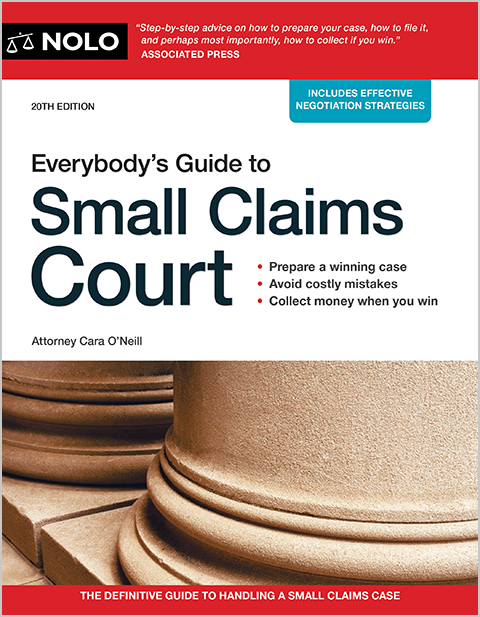A guide to wage garnishments after judgment, including how to get a writ of garnishment, federal and state limits on how much you can collect, and more.
Winning your court case was the easy part. Now, you have to figure out how to turn your money judgment into cash. When the person who owes you money (the "judgment debtor") brings home a steady paycheck, wage garnishment can be an effective way to collect.
A wage garnishment lets you recover up to 25% of a judgment debtor's take-home pay, subject to important limits we describe below. The garnishment process varies from one state to the next, but the basics we outline here are fairly consistent across all states. The keys are understanding when a wage garnishment makes financial sense, and making sure you do it right the first time.
Before jumping into wage garnishments, you might find it helpful to start with an overview of the collection process.
When You Can Garnish Wages
Wage garnishment isn't a viable option in all circumstances. A few states—Pennsylvania, North Carolina, and South Carolina are examples—limit the kinds of debts for which wage garnishments can be used. When wage garnishment isn't an option, consider alternatives like attaching bank accounts or recording judgment liens.
In those states where wage garnishment can be used to collect a general judgment debt, don't start the process without first making sure the judgment debtor's situation is a good fit. And of course, you'll also need to know where the judgment debtor works.
Learn more about common judgment collection problems you might face.
Is the Judgment Debtor's Situation a Good Fit?
These are the factors to look for when deciding if wage garnishment is a viable collection strategy.
- A regular paycheck. The judgment debtor must take home a regular, periodic paycheck. Earnings from self employment aren't a substitute for wages earned from employment. Gig work—for example, driving for a rideshare or meal-delivery service—is probably self employment. Check your state law to confirm.
- Sufficient income. Both federal and state laws require that the judgment debtor's net earnings must exceed specific thresholds. State income floors might be more or less generous than the federal limit. See "Limits on Wage Garnishments," below.
- Other wage garnishments. As a rule, wage garnishment is "first-come, first-served." In other words, the first creditor to garnish shuts out those who come later, if (as is likely) the first creditor takes the maximum amount allowed by law. Some kinds of debts—child support and taxes are good examples—are exceptions, meaning they jump to the front of the garnishment line.
Wage garnishment won't be an option if the judgment debtor quits their job. Some will do that to avoid paying. And when a judgment debtor declares bankruptcy, that automatically slams the brakes on any garnishments as well.
Finding Out Where the Judgment Debtor Works
To garnish a judgment debtor's wages, you first need to know where they work. Here are some low-cost ways to find out.
- Internet and social networks. An internet search, using the judgment debtor's name, city and state of residence, and other details might turn up employment information. Social networking sites like LinkedIn and Facebook can be especially helpful.
- Post-judgment interrogatories. State law probably lets you send the judgment debtor post-judgment interrogatories—written questions they must answer in writing and under oath. Questions typically cover the judgment debtor's financial situation, bank accounts, other property ownership, and employment. You might have to ask the court's permission (by filing a motion) before you send them.
- Judgment debtor examination. A more expensive but very useful tool is called the judgment debtor examination. After getting the court's permission (again, by filing a motion), you get to ask the judgment debtor questions, which they must answer under oath. Among other topics, your questions will cover the judgment debtor's employment.
Should You Garnish the Judgment Debtor's Wages?
The decision to garnish a judgment debtor's wages requires that you balance risk against reward. On the reward side, a successful garnishment means you get paid at least some of what you're owed. Even if you don't recover the full amount, something is better than nothing.
Occasionally, the mere threat of a wage garnishment will be enough to convince the judgment debtor to get out their checkbook. Though federal law prohibits an employer from firing an employee solely because of a single wage garnishment, the process might cause their employer to hold them in lower regard. In addition, they probably want to avoid having co-workers and friends know about their financial embarrassment.
On the risk side, there's always a chance that garnishment will push the judgment debtor into filing for bankruptcy. Should that happen, you'll probably find yourself near the end of a long line of very unhappy, very unsatisfied creditors. Unfortunately, the odds that you'll recover your judgment are slim.
How to Garnish a Judgment Debtor's Wages
The starting point is your state's wage garnishment law. Once you're familiar with the legal basics, here's an overview of the typical garnishment process:
- locate state-specific forms and guidance
- get a writ of garnishment
- serve the writ on the employer and provide a copy to the judgment debtor
- respond to any employer or judgment debtor objections or exemption claims, and
- track payments and monitor compliance.
Locate State-Specific Forms and Guidance
When it comes to wage garnishment, there's no need to reinvent the wheel. Chances are your state has pre-approved forms and instructions you must follow. Check your state's main court website or your local county court's webpage. You might also have luck on a state or local legal aid or bar association website.
Here are some examples.
- Orange County, California. Orange County Courts Self-Help Services offers a wage garnishment forms package. Once you've completed the forms, you can ask Self-Help Services to review them before you file.
- Michigan. Michigan's Supreme Court Administrative Office has compiled this garnishment forms resource page.
- Georgia. The Georgia Council of Superior Court Clerks provides a helpful garnishment forms page, and you can use this interactive guide and file service to prepare forms (including garnishment forms) online.
- Washington. These garnishment forms can be used in Washington state courts.
- Maryland. The People's Law Library of Maryland has this wage garnishment explanation page, including links to pre-approved forms.
- Florida. Florida's Eighth Judicial Circuit (covering Alachua, Baker, Bradford, Gilchrist, Levy, and Union counties) provides this collection information sheet, which includes garnishment forms.
Get a Writ of Garnishment
Once you've located the necessary forms and learned about the procedures involved, your next step will be to apply to the court for a writ of garnishment. Your state might call it something else, like a "writ of execution." Regardless of what it's called, don't be intimidated by the legalese.
A "writ" is simply a court order. What you're doing in this step, then, is asking the court for an order allowing you to garnish the judgment debtor's wages. You do that by submitting a completed writ application (it might be called a "motion") and paying the required fee (usually between $25 and $75). Typically, you'll apply for a writ in the same court that issued your judgment.
In some states, the court clerk can issue your writ. If not, the clerk will submit your application to the judge for approval.
Serve the Writ and Copy the Judgment Debtor
After the clerk or the judge signs your writ application or issues a separate wage garnishment order, you must arrange to have the writ served on the judgment debtor's employer. Proper service is crucial, so check your local rules to find out what's required. Common service options include:
- certified mail (get a return receipt to prove delivery)—when it's allowed, this will be the fastest and lowest-cost option
- personal service by the sheriff—the cost will typically range from $30 to $75, plus mileage, and is first-come, first-served, meaning your service request starts at the back of the line, and
- personal service by a private process server—generally faster than service by the sheriff, but the cost will be from $150 to $250.
You'll need to deliver a copy of the writ to the judgment debtor. Check to see if you also have to send a pre-approved notice or information form explaining the judgment debtor's rights to object and to claim state law exemptions. The required notice should be available with the state's standard wage garnishment forms.
Respond to Objections or Exemption Claims
The employer and judgment debtor have a limited amount of time—20 to 30 days is common—to respond to the writ and (for the judgment debtor) to request that the court allow them to use exemptions. The employer's response will indicate:
- whether the judgment debtor is currently employed
- the judgment debtor's employment dates
- their wage, salary, and pay schedule, and
- whether other wage garnishments are already in effect.
You'll have a chance to respond when there are objections to the writ or the judgment debtor claims exemptions. Before you do, think about getting advice from a local collections attorney.
If the judgment debtor isn't currently employed, or if other garnishments have exhausted the allowed garnishment limit, the writ will be returned "nulla bona" or "zero return," indicating that no wages were available to be garnished. That likely puts you back at square one, meaning you must start the writ process anew.
Track Payments and Monitor Compliance
When wage garnishment begins, the judgment debtor's employer will withhold the required amount and deliver it (directly to you or, in some states, to the sheriff or the court that issued the writ) each pay period. It's up to you to monitor withholdings and payments and to act if anything goes wrong. The court won't keep an eye on the garnishee (the judgment debtor's employer) unless you ask it to step in.
Payments will stop when:
- the judgment debtor quits or is fired
- another wage garnishment jumps the line and takes priority, or
- your judgment debt is fully paid.
Once you've been paid in full, you must file a satisfaction of judgment with the court and send a copy to the judgment debtor.
Limits on Wage Garnishments
Both federal and state laws put limits on when and how much of a judgment debtor's wages you can garnish. Familiarize yourself with the applicable limits so you can decide whether it makes financial sense to pursue wage garnishment as a collection strategy.
(Learn more about your rights if your wages are being garnished or you're being threatened with garnishment.)
Federal Law Limits
Under federal law, you can't garnish more than the lesser of:
- Test 1: 25% of the debtor's disposable earnings (what's left after mandatory deductions), or
- Test 2: the amount by which the debtor's wages exceed 30 times the minimum wage (presently, $7.25 x 30 = $217.50, though note that some states and localities have adopted a higher minimum wage).
(15 U.S.C. § 1673(a) (2025).)
How do these limits work? For starters, "disposable earnings" means the judgment debtor's take-home pay after all legally required deductions for federal and state taxes. As a rule, voluntary deductions for 401k contributions, life or health insurance, or union dues aren't included.
- Example 1: Low-wage worker. The judgment debtor earns $300 weekly with $60 in required deductions, leaving $240 in take-home pay. Under Test 1, 25% of this amount comes to $60. Under Test 2, subtract $217.50 from take home pay of $240, which equals $22.50. Because $22.50 is less than $60, the garnishment limit is $22.50 per week.
- Example 2: Mid-wage worker. The judgment debtor earns $600 each week with $132 in federal and state tax deductions, leaving net pay of $468. Under Test 1, multiply $468 by 25%, which comes to $117. Using Test 2, subtract $217.50 from $468, leaving $250.50. The employer will garnish $117 from the judgment debtor's weekly pay.
- Example 3: High-wage worker. The judgment debtor grosses $1,200 per week and the employer deducts $284 for taxes, leaving disposable income of $916. Test 1 yields a garnishment of $916 x 25%, or $229. Under Test 2 ($916 - $217.50), the maximum garnishment is $698.50. The employer will withhold the lower amount, $229.
- Example 4: Very low-wage worker. The judgment debtor's weekly gross is just $250 with $40 in deductions, meaning take-home pay comes to $210. The Test 1 garnishment is $210 x 25%, or $52.50. Test 2 works like this: $210 - $217.50 = -$7.50. Because we use the lower figure (-$7.50), nothing can be garnished from this judgment debtor's wages.
These limits don't apply to certain wage garnishments. For instance, when your judgment is for child or spousal support, you can garnish up to 50% of the judgment debtor's take-home pay (55% if the debtor is 12 or more weeks in arrears). If the judgment debtor doesn't currently support a spouse or child, you can garnish up to 60% of the wages (65% if the debtor is 12 or more weeks in arrears). (15 U.S.C. § 1673(b) (2025).)
State Law Limits
State law might protect more or less income than what federal law allows. State income thresholds often are keyed to federal poverty guidelines. New Jersey, for example, limits most wage garnishments to 10% of wages up to 250% of the federal poverty amount for a household of the judgment debtor's size.
Other states have enacted more specific exemptions. In Florida, the first $750 in weekly wages of a head of household are exempt from garnishment, and special rules protect head of household wages exceeding $750.
Get Help With Your Wage Garnishment
Can't find information about wage garnishments in your state? Don't give up. When court, state bar association, and legal aid websites don't offer the help you need, give some thought to consulting with an experienced collections lawyer. This is someone who knows your state's garnishment laws, judgment debtor exemptions, and the court rules and procedures you need to follow.
Even if you want to do most of the legwork on your own, buying an hour or two of attorney time can help you formulate a plan and navigate your way through the minefield of judgment debtor and consumer protection regulations. By working more efficiently and effectively, you can maximize the return on your wage garnishment investment and pocket more money in the long run.



